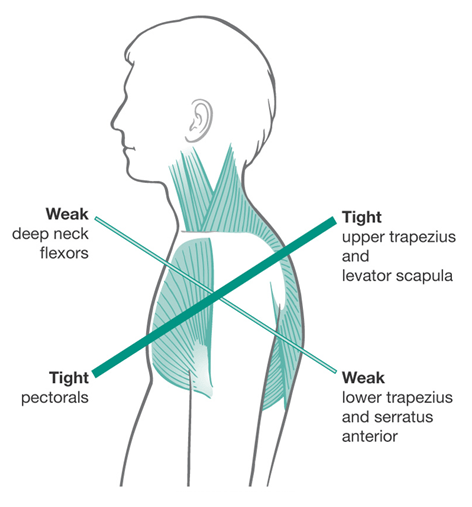When it comes to everyday posture, it can be tough to keep balanced. The most common imbalance I treat is a forward head and shoulders that causes pain in the neck and back (see last week’s post). Have you noticed this type of posture in other people – or even in yourself?
WHAT DOES IMBALANCE LOOK LIKE?
The abnormal posture and compromised movement associated with imbalance can be seen in others as they go about their normal daily activities. There was a physician from Prague who noticed this in patients during the process of physical rehabilitation. Vladimir Janda identified three stereotypical patterns associated with distinct chronic pain syndromes. The pattern related to a forward head is called Upper Crossed Syndrome (UCS).
UCS is characterized by tight and weak muscles that cross over the front and back sides of the body. This imbalance creates stress on joints of the spine and shoulders that will then cause further instability and lead to chronic pain and dysfunction.
Tight Muscles:
-suboccipitals/upper trapezius/levator scapula on the back
-pectoralis major/minor on the front
Weak Muscles:
-rhomboids/lower trapezius/serratus anterior on the back
-deep neck flexors on the front

PICTURE IT THIS WAY
Think of looking at a person from the side as they are standing. Imagine the head resting about 2-3 inches forward and the shoulders slightly raised and rounded forward. This describes a LOT of people, and now you will probably start noticing it more in the people around you.
The TIGHT muscles in the chest (pectorals) are pulling the shoulders forward and inward. Because the neck is tilted forward, the head would normally be pointed down. But because our eyes like to be level with the horizon in front of us, the muscles at the back of the head (suboccipitals) are constantly overworked to keep the head tilted up. This constant tension creates stiffness in the joints of the upper neck and is a common source of neck pain and headaches. These are your rock-solid areas that hurt when somebody pushes on them.
The WEAK muscles that would normally counteract these movements are located on the opposite sides of the tight muscles. Those in charge of bringing the head back on top of the shoulders where it’s supposed to be are in the front of the neck, under the area of the jaw. The muscles that should pull the shoulders back and down are below the shoulder blades. Think of these muscles as being tired and weak, being stretched longer and longer to the point where they are just barely working at all.
What if these pains could go away? What if Favero Chiropractic could help you feel better? Return next week to learn how we combine several methods of treatment for Upper Crossed Syndrome.
